#kenji taniguchi
Explore tagged Tumblr posts
Text

A new method to control quantum bound states in superconducting device
Researchers have successfully controlled the quantum mechanical properties of Andreev bound states in bilayer graphene-based Josephson junctions using gate voltage. Their research is published in Physical Review Letters. The research team includes Professors Gil-Ho Lee and Gil Young Cho from the Department of Physics at Pohang University of Science and Technology (POSTECH) in South Korea in collaboration with Dr. Kenji Watanabe and Dr. Takashi Taniguchi from National Institute for Materials Science (NIMS) in Japan. Superconductors are materials that exhibit zero electrical resistance under specific conditions such as extremely low temperatures or high pressures. When a very thin normal conductor is placed between two superconductors, a supercurrent flows through the normal conductor due to the proximity effect where superconductivity extends into the normal conductor. This device is known as a Josephson junction.
Read more.
#Materials Science#Science#Superconductors#Superconductivity#Quantum mechanics#Graphene#Layered materials#POSTECH
13 notes
·
View notes
Text
youtube
Code Geass: Rozé of the Recapture - PV1
Code Geass: Rozé of the Recapture (originally titled Gode Geass: Z of the Recapture) will have four parts that will screen in Japan in 2024.
Japanese theatrical dates:
Part 1 - May 10, 2024
Part 2 - June 7, 2024
Part 3 - July 5, 2024
Part 4 - August 2, 2024

Key visual
Cast addition

Reina Ueda as Sakuya

Kana Ichinose as Chalice

Hiroki Yasumoto as Noland

Nao Tōyama as Catherine

Yumi Uchiyama as Narah

Daisuke Hirakawa as Stanley

Yasuyuki Kase as Walter

Masaaki Mizunaka as Divock

Hiroyuki Yoshino as Kristoff

Ryota Ohsaka as Heath

Sōma Saitō as Arnold

Hirofumi Nojima as Greed

Yūki Ono as Gran
Previously announced cast members
Kōhei Amasaki as Rozé
Makoto Furukawa as Ash
Staff
Director: Yoshimitsu Ohashi
Series Composition: Noboru Kimura
Music: Kenji Kawai
Original Story: Goro Taniguchi, Ichiro Okouchi
Original Character Design: CLAMP
Character Design: Shuichi Shimamura, Takahiro Kimura
Art Director: Kazuhiro Obata
Mechanical design: Satoshi Shigeta
Sound Director: Jin Aketagawa
Cgi Director: Shūji Shinoda
Director of Photography: Hiroyuki Chiba
Color Design: Ami Kutsuna, Yuichi Kuboki
Editing: Kumiko Sakamoto
Knightmare Frame Design: Junichi Akutsu
Main Animator: Satoshi Shigeta, Seiichi Nakatani, Shuichi Shimamura, Takahiro Kimura, Takashi Hashimoto
Knightmare Design: Astrays
3DCGI: Buemon
Animation Production: Sunrise
#Code Geass#Code Geass Roze of the Recapture#Sunrise#film#anime#anime film#Code Geass Z of the Recapture#long post
19 notes
·
View notes
Text
New transistor’s superlative properties could have broad electronics applications
New Post has been published on https://thedigitalinsider.com/new-transistors-superlative-properties-could-have-broad-electronics-applications/
New transistor’s superlative properties could have broad electronics applications
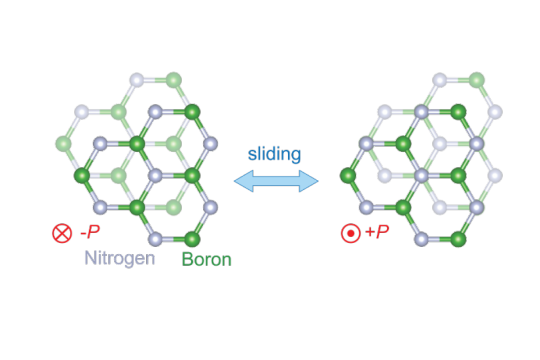

In 2021, a team led by MIT physicists reported creating a new ultrathin ferroelectric material, or one where positive and negative charges separate into different layers. At the time they noted the material’s potential for applications in computer memory and much more. Now the same core team and colleagues — including two from the lab next door — have built a transistor with that material and shown that its properties are so useful that it could change the world of electronics.
Although the team’s results are based on a single transistor in the lab, “in several aspects its properties already meet or exceed industry standards” for the ferroelectric transistors produced today, says Pablo Jarillo-Herrero, the Cecil and Ida Green Professor of Physics, who led the work with professor of physics Raymond Ashoori. Both are also affiliated with the Materials Research Laboratory.
“In my lab we primarily do fundamental physics. This is one of the first, and perhaps most dramatic, examples of how very basic science has led to something that could have a major impact on applications,” Jarillo-Herrero says.
Says Ashoori, “When I think of my whole career in physics, this is the work that I think 10 to 20 years from now could change the world.”
Among the new transistor’s superlative properties:
It can switch between positive and negative charges — essentially the ones and zeros of digital information — at very high speeds, on nanosecond time scales. (A nanosecond is a billionth of a second.)
It is extremely tough. After 100 billion switches it still worked with no signs of degradation.
The material behind the magic is only billionths of a meter thick, one of the thinnest of its kind in the world. That, in turn, could allow for much denser computer memory storage. It could also lead to much more energy-efficient transistors because the voltage required for switching scales with material thickness. (Ultrathin equals ultralow voltages.)
The work is reported in a recent issue of Science. The co-first authors of the paper are Kenji Yasuda, now an assistant professor at Cornell University, and Evan Zalys-Geller, now at Atom Computing. Additional authors are Xirui Wang, an MIT graduate student in physics; Daniel Bennett and Efthimios Kaxiras of Harvard University; Suraj S. Cheema, an assistant professor in MIT’s Department of Electrical Engineering and Computer Science and an affiliate of the Research Laboratory of Electronics; and Kenji Watanabe and Takashi Taniguchi of the National Institute for Materials Science in Japan.
What they did
In a ferroelectric material, positive and negative charges spontaneously head to different sides, or poles. Upon the application of an external electric field, those charges switch sides, reversing the polarization. Switching the polarization can be used to encode digital information, and that information will be nonvolatile, or stable over time. It won’t change unless an electric field is applied. For a ferroelectric to have broad application to electronics, all of this needs to happen at room temperature.
The new ferroelectric material reported in Science in 2021 is based on atomically thin sheets of boron nitride that are stacked parallel to each other, a configuration that doesn’t exist in nature. In bulk boron nitride, the individual layers of boron nitride are instead rotated by 180 degrees.
It turns out that when an electric field is applied to this parallel stacked configuration, one layer of the new boron nitride material slides over the other, slightly changing the positions of the boron and nitrogen atoms. For example, imagine that each of your hands is composed of only one layer of cells. The new phenomenon is akin to pressing your hands together then slightly shifting one above the other.
“So the miracle is that by sliding the two layers a few angstroms, you end up with radically different electronics,” says Ashoori. The diameter of an atom is about 1 angstrom.
Another miracle: “nothing wears out in the sliding,” Ashoori continues. That’s why the new transistor could be switched 100 billion times without degrading. Compare that to the memory in a flash drive made with conventional materials. “Each time you write and erase a flash memory, you get some degradation,” says Ashoori. “Over time, it wears out, which means that you have to use some very sophisticated methods for distributing where you’re reading and writing on the chip.” The new material could make those steps obsolete.
A collaborative effort
Yasuda, the co-first author of the current Science paper, applauds the collaborations involved in the work. Among them, “we [Jarillo-Herrero’s team] made the material and, together with Ray [Ashoori] and [co-first author] Evan [Zalys-Geller], we measured its characteristics in detail. That was very exciting.” Says Ashoori, “many of the techniques in my lab just naturally applied to work that was going on in the lab next door. It’s been a lot of fun.”
Ashoori notes that “there’s a lot of interesting physics behind this” that could be explored. For example, “if you think about the two layers sliding past each other, where does that sliding start?” In addition, says Yasuda, could the ferroelectricity be triggered with something other than electricity, like an optical pulse? And is there a fundamental limit to the amount of switches the material can make?
Challenges remain. For example, the current way of producing the new ferroelectrics is difficult and not conducive to mass manufacturing. “We made a single transistor as a demonstration. If people could grow these materials on the wafer scale, we could create many, many more,” says Yasuda. He notes that different groups are already working to that end.
Concludes Ashoori, “There are a few problems. But if you solve them, this material fits in so many ways into potential future electronics. It’s very exciting.”
This work was supported by the U.S. Army Research Office, the MIT/Microsystems Technology Laboratories Samsung Semiconductor Research Fund, the U.S. National Science Foundation, the Gordon and Betty Moore Foundation, the Ramon Areces Foundation, the Basic Energy Sciences program of the U.S. Department of Energy, the Japan Society for the Promotion of Science, and the Ministry of Education, Culture, Sports, Science and Technology (MEXT) of Japan.
#2-D#affiliate#applications#atom#atoms#author#billion#boron nitride#career#Cells#change#chip#collaborative#computer#computer memory#Computer Science#Computer science and technology#computing#education#electric field#Electrical Engineering&Computer Science (eecs)#electricity#Electronics#energy#engineering#flash#Foundation#Fundamental#Future#green
2 notes
·
View notes
Text
Hidden transport pathways in graphene confirmed, paving the way for next-generation device innovation
Electron transport in bilayer graphene exhibits a pronounced dependence on edge states and a nonlocal transport mechanism, according to a recent study led by Professor Gil-Ho Lee and Ph.D. candidate Hyeon-Woo Jeong of POSTECH’s Department of Physics, in collaboration with Dr. Kenji Watanabe and Dr. Takashi Taniguchi at Japan’s National Institute for Materials Science (NIMS). The findings were…
0 notes
Text
New transistor’s superlative properties could have broad electronics applications
New Post has been published on https://sunalei.org/news/new-transistors-superlative-properties-could-have-broad-electronics-applications/
New transistor’s superlative properties could have broad electronics applications

In 2021, a team led by MIT physicists reported creating a new ultrathin ferroelectric material, or one where positive and negative charges separate into different layers. At the time they noted the material’s potential for applications in computer memory and much more. Now the same core team and colleagues — including two from the lab next door — have built a transistor with that material and shown that its properties are so useful that it could change the world of electronics.
Although the team’s results are based on a single transistor in the lab, “in several aspects its properties already meet or exceed industry standards” for the ferroelectric transistors produced today, says Pablo Jarillo-Herrero, the Cecil and Ida Green Professor of Physics, who led the work with professor of physics Raymond Ashoori. Both are also affiliated with the Materials Research Laboratory.
“In my lab we primarily do fundamental physics. This is one of the first, and perhaps most dramatic, examples of how very basic science has led to something that could have a major impact on applications,” Jarillo-Herrero says.
Says Ashoori, “When I think of my whole career in physics, this is the work that I think 10 to 20 years from now could change the world.”
Among the new transistor’s superlative properties:
It can switch between positive and negative charges — essentially the ones and zeros of digital information — at very high speeds, on nanosecond time scales. (A nanosecond is a billionth of a second.)
It is extremely tough. After 100 billion switches it still worked with no signs of degradation.
The material behind the magic is only billionths of a meter thick, one of the thinnest of its kind in the world. That, in turn, could allow for much denser computer memory storage. It could also lead to much more energy-efficient transistors because the voltage required for switching scales with material thickness. (Ultrathin equals ultralow voltages.)
The work is reported in a recent issue of Science. The co-first authors of the paper are Kenji Yasuda, now an assistant professor at Cornell University, and Evan Zalys-Geller, now at Atom Computing. Additional authors are Xirui Wang, an MIT graduate student in physics; Daniel Bennett and Efthimios Kaxiras of Harvard University; Suraj S. Cheema, an assistant professor in MIT’s Department of Electrical Engineering and Computer Science and an affiliate of the Research Laboratory of Electronics; and Kenji Watanabe and Takashi Taniguchi of the National Institute for Materials Science in Japan.
What they did
In a ferroelectric material, positive and negative charges spontaneously head to different sides, or poles. Upon the application of an external electric field, those charges switch sides, reversing the polarization. Switching the polarization can be used to encode digital information, and that information will be nonvolatile, or stable over time. It won’t change unless an electric field is applied. For a ferroelectric to have broad application to electronics, all of this needs to happen at room temperature.
The new ferroelectric material reported in Science in 2021 is based on atomically thin sheets of boron nitride that are stacked parallel to each other, a configuration that doesn’t exist in nature. In bulk boron nitride, the individual layers of boron nitride are instead rotated by 180 degrees.
It turns out that when an electric field is applied to this parallel stacked configuration, one layer of the new boron nitride material slides over the other, slightly changing the positions of the boron and nitrogen atoms. For example, imagine that each of your hands is composed of only one layer of cells. The new phenomenon is akin to pressing your hands together then slightly shifting one above the other.
“So the miracle is that by sliding the two layers a few angstroms, you end up with radically different electronics,” says Ashoori. The diameter of an atom is about 1 angstrom.
Another miracle: “nothing wears out in the sliding,” Ashoori continues. That’s why the new transistor could be switched 100 billion times without degrading. Compare that to the memory in a flash drive made with conventional materials. “Each time you write and erase a flash memory, you get some degradation,” says Ashoori. “Over time, it wears out, which means that you have to use some very sophisticated methods for distributing where you’re reading and writing on the chip.” The new material could make those steps obsolete.
A collaborative effort
Yasuda, the co-first author of the current Science paper, applauds the collaborations involved in the work. Among them, “we [Jarillo-Herrero’s team] made the material and, together with Ray [Ashoori] and [co-first author] Evan [Zalys-Geller], we measured its characteristics in detail. That was very exciting.” Says Ashoori, “many of the techniques in my lab just naturally applied to work that was going on in the lab next door. It’s been a lot of fun.”
Ashoori notes that “there’s a lot of interesting physics behind this” that could be explored. For example, “if you think about the two layers sliding past each other, where does that sliding start?” In addition, says Yasuda, could the ferroelectricity be triggered with something other than electricity, like an optical pulse? And is there a fundamental limit to the amount of switches the material can make?
Challenges remain. For example, the current way of producing the new ferroelectrics is difficult and not conducive to mass manufacturing. “We made a single transistor as a demonstration. If people could grow these materials on the wafer scale, we could create many, many more,” says Yasuda. He notes that different groups are already working to that end.
Concludes Ashoori, “There are a few problems. But if you solve them, this material fits in so many ways into potential future electronics. It’s very exciting.”
This work was supported by the U.S. Army Research Office, the MIT/Microsystems Technology Laboratories Samsung Semiconductor Research Fund, the U.S. National Science Foundation, the Gordon and Betty Moore Foundation, the Ramon Areces Foundation, the Basic Energy Sciences program of the U.S. Department of Energy, the Japan Society for the Promotion of Science, and the Ministry of Education, Culture, Sports, Science and Technology (MEXT) of Japan.
0 notes
Text
"Bleach: Seven Seals" OFFICIAL Character Artwork!!!
Designs for Characters featured in "Bleach: Seven Seals", and other affiliated works!
Below will be an ever edited document of all Official Pokémon in the order of the Pokédex!!!
Link to Story -
_____________________________________________________________
Cecilia Davenport

Hishi Kanchuague

Anzu Ohno

Sana Fujita
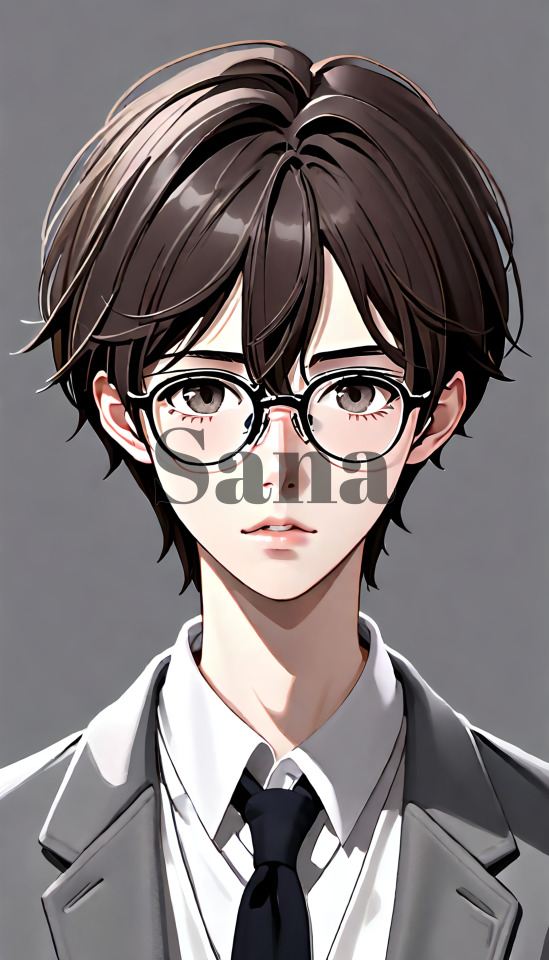
Henry Onishi

Koji Nakamura

Mr. and Mrs. Nakamura

"The Blossoms"
Ichika Taniguchi, Ren Sasaki, and Himari Ito

Owari Tsuigeki

Mrs. Kaneko

Mrs. Yowamushi

Malcolm Modegi - "Founder and Director of Modegi Mod"
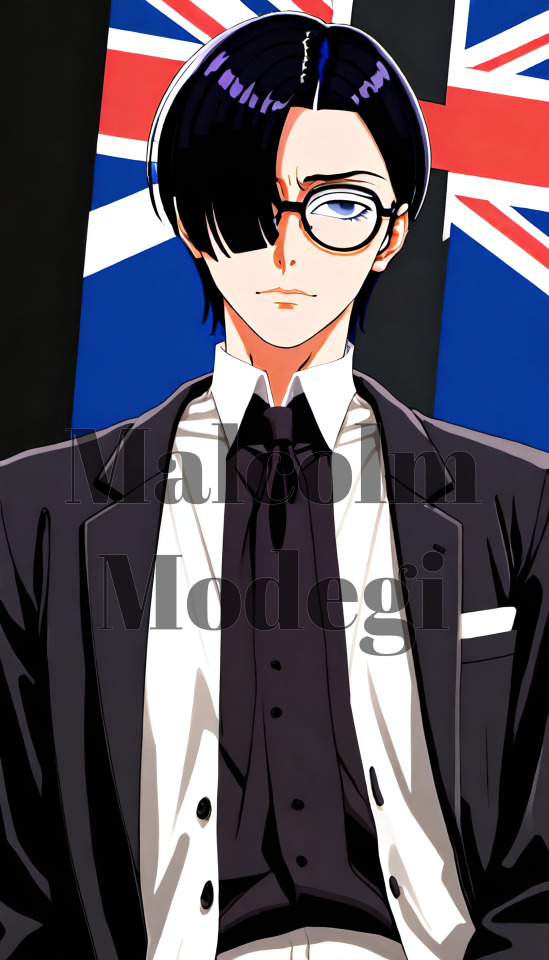
Kazuhiko Suzunami - "3rd Seat of Squad 13 of the 13 Court Guard Squads"

Reo Hasegawa - "8th seat of Squad 2 of the 13 Court Guard Squads"

Machina X - "3rd Seat of Squad 12 of the 13 Court Guard Squads"

Masumi Kudō - "3rd Seat of Squad 5 of the 13 Court Guard Squads"

Kenji Kudō - "4th Seat of Squad 5 of the 13 Court Guard Squads"

Kiemon Nimaiya - "3rd Seat of Squad 9 of the 13 Court Guard Squads"

Yumeko Hoshizora - "Student President of Karakura High School"

Kaito Shinonome - "Violinist of the Reikon no Kōkyō"

Radley Hayabusa - "Self-proclaimed 'raddest dude in all of Karakura!'"

0 notes
Text
youtube
【Genesis】 Contra: Hard Corps | 魂斗羅 ザ・ハードコア ~Attract demo
// Music: Hiroshi "Devi" Kobayashi | 小林裕, Akiropito | あきろぴと, Kenji Miyaoka Chiru2 / Michiru Yamane | 山根ミチル, Gajokai / Akira Yamaoka | 山岡晃, Nitachigu / Hirofumi Taniguchi | 谷口博史
// MiSTer FPGA // Genesis core // Y/C Composite // Sony KV-13TR20 CRT
1 note
·
View note
Text
New breakbeat compilation!
#music#new music#dj tools#electronica#breaks#breakbeat#edm news#chillwave#drum and bass#dnbdance#dnbfamily#djlife#good music#takeaway#kenji taniguchi#danja#Spotify
1 note
·
View note
Text
Kamen Rider Amazons Season 1 Coming to North America
Kamen Rider Amazons Season 1 Coming to North America
Today, Amazon announced that Kamen Rider Amazons will be added to its North American Prime streaming services on Friday, April 7th. Amazon will start with Kamen Rider Amazons’ Season 1, and will upload following episodes weekly. The North American launch of the series is to coincide with Season 2’s premiere in Japan. The episodes will feature English, Spanish, and French subtitles. Amazonalso…
View On WordPress
#Amazon Exclusive#Amazon Prime#Amazon Prime Japan#April Fools#Bandai#Featured#Kamen Rider#Kamen Rider Amazon Alpha#Kamen Rider Amazons#Kamen Rider Omega#Kamen Rider Sigma#Kenji Taniguchi#Premium Bandai#S.H. Figuarts#S.H.Figuarts Kamen Rider Amazon Alpha.#S.H.Figuarts Kamen Rider Amazon Omega#S.H.Figuarts Kamen Rider Amazon Sigma#Shotaro Ishinomori#Tamashii Nations#Toku News#Tokusatsu#Tom Fujita#Yu Kamio
14 notes
·
View notes
Text
Bungo Stray Dogs the Movie: BEAST 2nd PV & Visual
BSD Beast Official revealed the second trailer & visual of Bungo Stray Dogs the Movie: BEAST. GRANRODEO as a theme song performer.

youtube
Cast members:
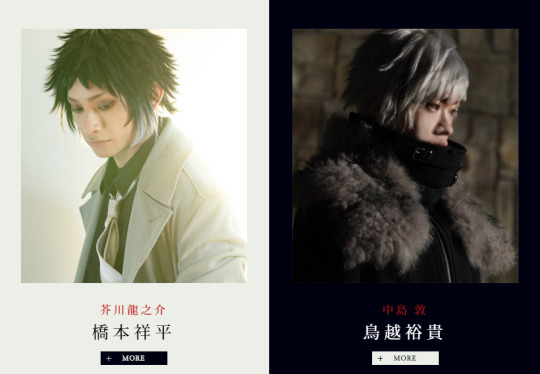
Akutagawa Ryunosuke - Hashimoto Shohei Nakajima Atsushi - Torigoe Yuki
Armed Detective Agency
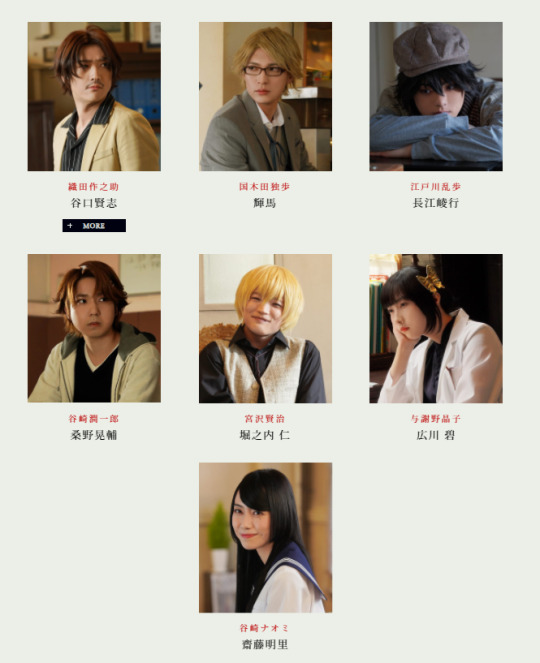
Oda Sakunosuke - Masashi Taniguchi Kunikida Doppo - Teruma Edogawa Ranpo - Nagae Ryoki Tanizaki Junichiro - Kuwano Kosuke Miyazawa Kenji - Horinochi Hitoshi Yosano Akiko - Imamura Miho Tanizaki Naomi - Saito Akari
Port Mafia
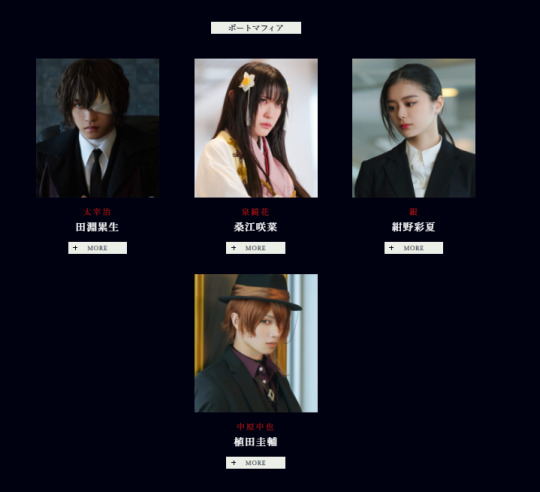
Dazai Osamu - Tabuchi Rui Izumi Kyoka - Kuwae Sakina Gin - Ayaka Konno Nakahara Chuya - Ueda Keisuke
Others
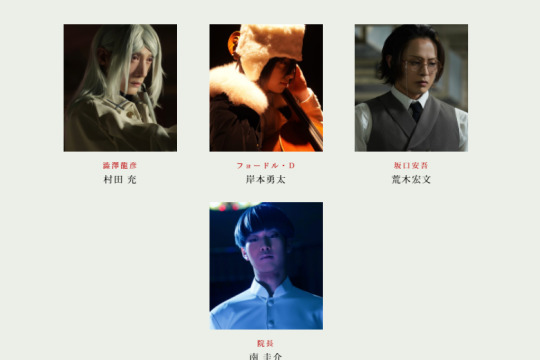
Shibusawa Tatsuhiko - Murata Mitsu Fyodor Dostoevsky - Kishimoto Yuta Sakaguchi Ango - Araki Hirofumi Director - Minami Keisuke
386 notes
·
View notes
Photo





Released 2005, this collaboration with J-regain featured 5 different charms (known as the young magazine figure collection, ヤングマガジン フィギュアコレクション) that could be picked up at certain convenience store chains The characters are as follows:
Gen (agonashi gen)
Kenji (agonashi gen)
Taniguchi (Kyogo aika Volley boys)
Taraka (Kyogo aika Volley boys)
And our boy, Kaiji, who was the only one that didn’t come with a second from the same series.
They were little plastic figures standing 4cm, not counting the chain, and were included in a little blue pouch attached to the drink This promotion seemed to go very well, as there are an insane amount of bulk listings for figures compared to other items we see. Along with that, they tend to run cheap as well! The bottles went for 294 yen
7 notes
·
View notes
Text
youtube
Code Geass: Rozé of the Recapture - New PV
Code Geass: Rozé of the Recapture (originally titled Gode Geass: Z of the Recapture) will have four parts that will screen in Japan starting in May 2024.
MIYAVI will perform the opening theme song “Running In My Head”.

Key visual
Cast

Kōhei Amasaki as Rozé
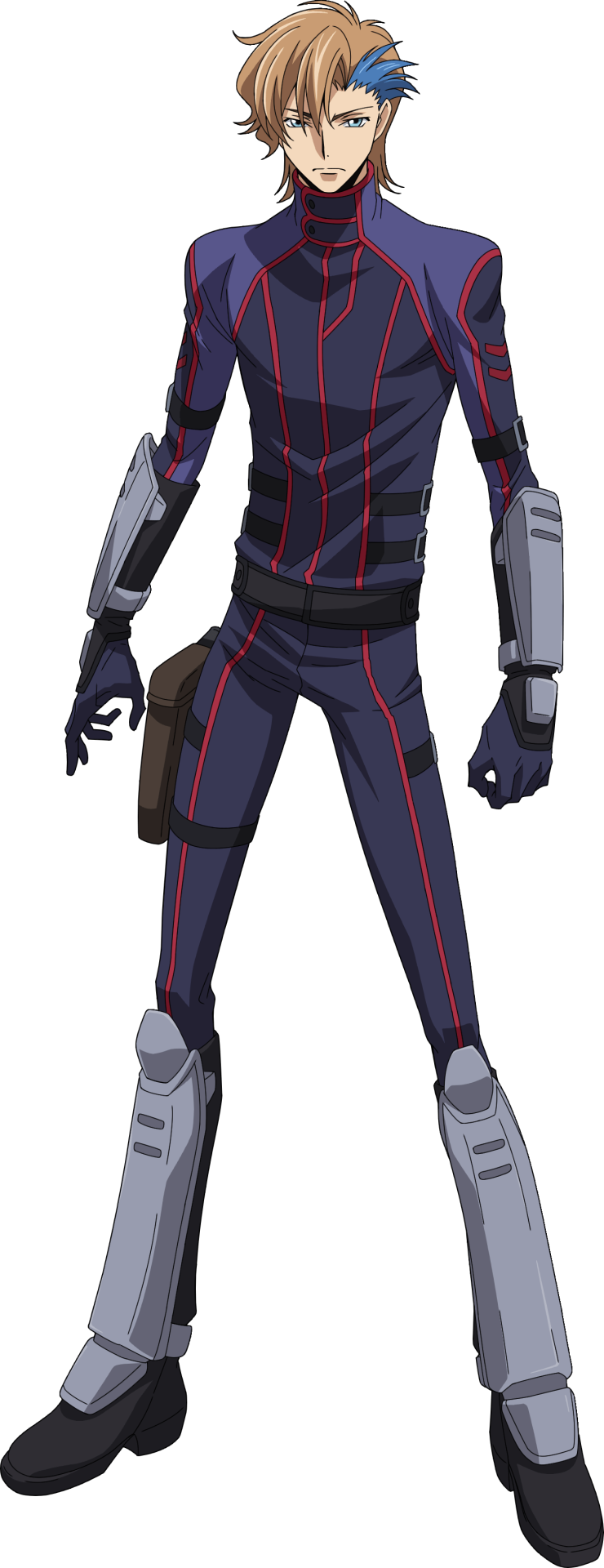
Makoto Furukawa as Ash
Staff
Director: Yoshimitsu Ohashi
Series Composition: Noboru Kimura
Music: Kenji Kawai
Original Story: Goro Taniguchi, Ichiro Okouchi
Original Character Design: CLAMP
Character Design: Shuichi Shimamura, Takahiro Kimura
Art Director: Kazuhiro Obata
Mechanical design: Satoshi Shigeta
Sound Director: Jin Aketagawa
Cgi Director: Shūji Shinoda
Director of Photography: Hiroyuki Chiba
Color Design: Ami Kutsuna, Yuichi Kuboki
Editing: Kumiko Sakamoto
Knightmare Frame Design: Junichi Akutsu
Main Animator: Satoshi Shigeta, Seiichi Nakatani, Shuichi Shimamura, Takahiro Kimura, Takashi Hashimoto
Knightmare Design: Astrays
3DCGI: Buemon
Animation Production: Sunrise
#Code Geass#Code Geass Roze of the Recapture#Sunrise#film#anime#anime film#Code Geass Z of the Recapture#long post
22 notes
·
View notes
Text
Watch Bungo Stray Dogs BEAST Live-action Film's Intense Ability Battles in New Clips
The official website for Bungo Stray Dogs the Movie BEAST, the first live-action film inspired by the Bungo Stray Dogs manga series created by Kafka Asagiri (story) and Sango Harukawa (arts), has posted three new clips introducing its intense action action scenes.
- The scene where the protagonist Ryunosuke Akutagawa (played by Shohei Hashimoto) overwhelms the members of Port Mafia, using his ability "Rashomon", which creates shadow-like blades from his cloak.
youtube
The scene where Atsushi Nakajima (Yuki Torigoe), Akutagawa's nemesis, transforms into a white tiger with his ability "Gekkaju" (Beast Beneath the Moonlight) and attacks enemy soldiers one after another from the darkness.
youtube
- The scene where Sakunosuke Oda (Kenshi Taniguchi) is engaged in a fierce gun battle using his "Teni Muhou" (Flawless) ability that can predict the future in seconds.
youtube
The film is based on the series' spin-off manga illustrated by Shiwasu Hoshikawa, which is set in a parallel world where the main character, Atsushi Nakajima, and his nemesis, Ryunosuke Akutagawa, belong to opposite organizations. All of the main cast members of the Bungo Stray Dogs stage play series, including Yuuki Torigoe as Atsushi Nakajima and Shohei Hashimoto as Ryunesuke Akutagawa, reprise their roles.
The Koichi Sakamoto (Power Rangers, Heisei Kamen Rider series, Ultraman series)-directed film is set to be released in Japan on January 7, 2022.
Full Trailer:
youtube
Poster visual with a tagline: "The 'beast' inside you will awaken."
Main cast:
Atsushi Nakajima: Yuuki Torigoe
Ryunosuke Akutagawa: Shohei Hashimoto
Gin: Ayaka Konno
Sakunosuke Oda: Kenshi Taniguchi
Doppo Kunikida: Teruma
Rampo Edogawa: Ryoki Nagae
Junichiro Tanizaki: Kosuke Kuwano
Kenji Miyazawa: Hitoshi Horinouchi
Akiko Yosano: Aoi Hirokawa
Naomi Tanizaki: Akari Saito
Osamu Dazai: Rui Tabuchi
Kyoka Izumi: Sakina Kuwae
Chuya Nakahara: Keisuke Ueda
Tatsuhiko Shibuzawa: Mitsu Murata
Fyodor Dostoyevsky: Yuta Kishimoto
Ango Sakaguchi: Hirofumi Araki
Source: "Bungo Stray Dogs the Movie BEAST" official website
©"Bungo Stray Dogs the Movie BEAST" Production Committee
By: Mikikazu Komatsu
7 notes
·
View notes
Text
Physicists create five-lane superhighway for electrons
New Post has been published on https://sunalei.org/news/physicists-create-five-lane-superhighway-for-electrons/
Physicists create five-lane superhighway for electrons

MIT physicists and colleagues have created a five-lane superhighway for electrons that could allow ultra-efficient electronics and more.
The work, reported in the May 10 issue of Science, is one of several important discoveries by the same team over the past year involving a material that is a unique form of graphene.
“This discovery has direct implications for low-power electronic devices because no energy is lost during the propagation of electrons, which is not the case in regular materials where the electrons are scattered,” says Long Ju, an assistant professor in the Department of Physics and corresponding author of the Science paper.
The phenomenon is akin to cars traveling down an open turnpike as opposed to those moving through neighborhoods. The neighborhood cars can be stopped or slowed by other drivers making abrupt stops or U-turns that disrupt an otherwise smooth commute.
A new material
The material behind this work, known as rhombohedral pentalayer graphene, was discovered two years ago by physicists led by Ju. “We found a goldmine, and every scoop is revealing something new,” says Ju, who is also affiliated with MIT’s Materials Research Laboratory.
In a Nature Nanotechnology paper last October, Ju and colleagues reported the discovery of three important properties arising from rhombohedral graphene. For example, they showed that it could be topological, or allow the unimpeded movement of electrons around the edge of the material but not through the middle. That resulted in a superhighway, but required the application of a large magnetic field some tens of thousands times stronger than the Earth’s magnetic field.
In the current work, the team reports creating the superhighway without any magnetic field.
Tonghang Han, an MIT graduate student in physics, is a co-first author of the paper. “We are not the first to discover this general phenomenon, but we did so in a very different system. And compared to previous systems, ours is simpler and also supports more electron channels.” Explains Ju, “other materials can only support one lane of traffic on the edge of the material. We suddenly bumped it up to five.”
Additional co-first authors of the paper who contributed equally to the work are Zhengguang Lu and Yuxuan Yao. Lu is a postdoc in the Materials Research Laboratory. Yao conducted the work as a visiting undergraduate student from Tsinghua University. Other authors are MIT professor of physics Liang Fu; Jixiang Yang and Junseok Seo, both MIT graduate students in physics; Chiho Yoon and Fan Zhang of the University of Texas at Dallas; and Kenji Watanabe and Takashi Taniguchi of the National Institute for Materials Science in Japan.
How it works
Graphite, the primary component of pencil lead, is composed of many layers of graphene, a single layer of carbon atoms arranged in hexagons resembling a honeycomb structure. Rhombohedral graphene is composed of five layers of graphene stacked in a specific overlapping order.
Ju and colleagues isolated rhombohedral graphene thanks to a novel microscope Ju built at MIT in 2021 that can quickly and relatively inexpensively determine a variety of important characteristics of a material at the nanoscale. Pentalayer rhombohedral stacked graphene is only a few billionths of a meter thick.
In the current work, the team tinkered with the original system, adding a layer of tungsten disulfide (WS2). “The interaction between the WS2 and the pentalayer rhombohedral graphene resulted in this five-lane superhighway that operates at zero magnetic field,” says Ju.
Comparison to superconductivity
The phenomenon that the Ju group discovered in rhombohedral graphene that allows electrons to travel with no resistance at zero magnetic field is known as the quantum anomalous Hall effect. Most people are more familiar with superconductivity, a completely different phenomenon that does the same thing but happens in very different materials.
Ju notes that although superconductors were discovered in the 1910s, it took some 100 years of research to coax the system to work at the higher temperatures necessary for applications. “And the world record is still well below room temperature,” he notes.
Similarly, the rhombohedral graphene superhighway currently operates at about 2 kelvins, or -456 degrees Fahrenheit. “It will take a lot of effort to elevate the temperature, but as physicists, our job is to provide the insight; a different way for realizing this [phenomenon],” Ju says.
Very exciting
The discoveries involving rhombohedral graphene came as a result of painstaking research that wasn’t guaranteed to work. “We tried many recipes over many months,” says Han, “so it was very exciting when we cooled the system to a very low temperature and [a five-lane superhighway operating at zero magnetic field] just popped out.”
Says Ju, “it’s very exciting to be the first to discover a phenomenon in a new system, especially in a material that we uncovered.”
This work was supported by a Sloan Fellowship; the U.S. National Science Foundation; the U.S. Office of the Under Secretary of Defense for Research and Engineering; the Japan Society for the Promotion of Science KAKENHI; and the World Premier International Research Initiative of Japan.
0 notes
Photo

[Announcement] 映画「文豪ストレイドッグス BEAST」(eiga bungou stray dogs beast)
roadshow: January 7th, 2022!!!
youtube
Cast:

Hashimoto Shouhei as Akutagawa Ryuunosuke (芥川龍之介)

Torigoe Yuuki as Nakajima Atsushi (中島敦)
Taniguchi Masahi as Oda Sakunosuke (織田作之助) Teruma as Kunikida Doppo (国木田独歩) Nagae Ryouki as Edogawa Ranpo (江戸川乱歩) Kuwano Kousuke as Tanizaki Junichirou (谷崎潤一郎) Horinouchi Hitoshi as Miyazawa Kenji (宮沢賢治) Imamura Ao as Yosano Akiko (与謝野晶子) Saitou Akari as Tanizaki Naomi (谷崎ナオミ) Tabuchi Rui as Dazai Osamu (太宰治) Kuwae Sakina as Izumi Kyouka (泉鏡花) Konno Ayaka as Kane (銀) Ueda Keisuke as Nakahara Chuuya (中原中也)
homepage twitter natalie
#文豪ストレイドッグス#bungou stray dogs#bungo stray dogs#橋本祥平#hashimoto shouhei#鳥越裕貴#torigoe yuuki#谷口賢志#taniguchi masashi#輝馬#teruma#長江崚行#nagae ryouki#桑野晃輔#kuwano kousuke#堀之内仁#horinouchi hitoshi#広川碧#imamura ao#齋藤明里#saitou akari#田淵累生#tabuchi rui#桑江咲菜#kuwae sakina#紺野彩夏#konno ayaka#植田圭輔#ueda keisuke
17 notes
·
View notes
